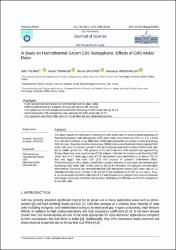| dc.contributor.author | Yılmaz, Salih | |
| dc.contributor.author | Tomakin, Murat | |
| dc.contributor.author | Ünverdi, Ahmet | |
| dc.contributor.author | Aboghalon, Abdulaziz | |
| dc.date.accessioned | 2020-12-19T20:44:25Z | |
| dc.date.available | 2020-12-19T20:44:25Z | |
| dc.date.issued | 2019 | |
| dc.identifier.citation | Yılmaz, S., Tomakin, M., Ünverdi, A., Aboghalon, A. (2019). A atudy on hydrothermal grown CdS nanospheres: effects of Cd/S molar ratio. Gazi University Journal of Science, 32(4), 1271-1281. | |
| dc.identifier.issn | 2147-1762 | |
| dc.identifier.issn | 2147-1762 | |
| dc.identifier.uri | https://doi.org/10.35378/gujs.513525 | |
| dc.identifier.uri | https://app.trdizin.gov.tr/makale/TXpNeU5EUTNOdz09 | |
| dc.identifier.uri | https://hdl.handle.net/11436/5991 | |
| dc.description.abstract | The study reports the influences of altering of Cd/S molar ratio on some physical properties of hydrothermal grown CdS nanospheres. Cd/S molar ratios were chosen as 1:0.5, 1:1, 1:2, 1:3 and 1:4 in the stock solution. X-ray diffraction (XRD) data showed the occurrence of nano-amorphous CdS structure. Scanning electron microscopy (SEM) conclusions illustrated that increasing Cd/S molar ratio up to 1:3 caused a growth in the sphere size whereas further rising of Cd/S molar ratio led to smaller sphere size. The presence of Cd and S atoms in CdS structure was approved by Energy dispersive x-ray spectroscopy (EDS) analysis. Optimum transparency was found by Cd/S molar ratio of 1:3. Band gap scores of CdS nanospheres were determined to be above 2.60 eV that was bigger than bulk CdS (2.42 eV) because of quantum confinement effect. Photoluminescence (PL) results showed that a gradual decrease in each peak was attained upon increasing Cd/S molar ratio, which could be due to the formation non-radiative recombination phenomenon. Electrical data demonstrated that CdS nanosphere having Cd/S molar ratio of 1:1 exhibited the best carrier density (1.48X1015cm-3) and resistivity (1.27X103 ?.cm) values. Thus, it can be deduced that Cd/S molar ratio of 1:3 was obtained to be optimum one since it possesses both bigger sphere size and better transparency, facilitating the effective use of CdS nanospheres in the solar cells. | en_US |
| dc.language.iso | eng | en_US |
| dc.rights | info:eu-repo/semantics/openAccess | en_US |
| dc.subject | Biyoloji | en_US |
| dc.subject | Kimya, Analitik | en_US |
| dc.subject | Kimya, Uygulamalı | en_US |
| dc.subject | Kimya, İnorganik ve Nükleer | en_US |
| dc.subject | Kimya, Tıbbi | en_US |
| dc.subject | Kimya, Organik | en_US |
| dc.subject | Matematik | en_US |
| dc.subject | Fizik, Uygulamalı | en_US |
| dc.subject | Fizik, Atomik ve Moleküler Kimya | en_US |
| dc.subject | Fizik, Katı Hal | en_US |
| dc.subject | Fizik, Akışkanlar ve Plazma | en_US |
| dc.subject | Fizik, Matematik | en_US |
| dc.subject | Fizik, Nükleer | en_US |
| dc.subject | Fizik, Partiküller ve Alanlar | en_US |
| dc.subject | İstatistik ve Olasılık | en_US |
| dc.subject | Mimarlık | en_US |
| dc.subject | Bilgisayar Bilimleri, Yapay Zeka | en_US |
| dc.subject | Bilgisayar Bilimleri, Sibernitik | en_US |
| dc.subject | Bilgisayar Bilimleri, Donanım ve Mimari | en_US |
| dc.subject | Bilgisayar Bilimleri, Bilgi Sistemleri | en_US |
| dc.subject | Bilgisayar Bilimleri, Yazılım Mühendisliği | en_US |
| dc.subject | Bilgisayar Bilimleri, Teori ve Metotlar | en_US |
| dc.subject | Mühendislik, Kimya | en_US |
| dc.subject | İnşaat Mühendisliği | en_US |
| dc.subject | Mühendislik, Elektrik ve Elektronik | en_US |
| dc.subject | Endüstri Mühendisliği | en_US |
| dc.subject | İmalat Mühendisliği | en_US |
| dc.subject | Mühendislik, Makine | en_US |
| dc.title | A atudy on hydrothermal grown CdS nanospheres: effects of Cd/S molar ratio | en_US |
| dc.type | article | en_US |
| dc.contributor.department | RTEÜ, Fen - Edebiyat Fakültesi, Fizik Bölümü | en_US |
| dc.contributor.institutionauthor | Tomakin, Murat | |
| dc.identifier.doi | 10.35378/gujs.513525 | |
| dc.identifier.volume | 32 | en_US |
| dc.identifier.issue | 4 | en_US |
| dc.identifier.startpage | 1271 | en_US |
| dc.identifier.endpage | 1281 | en_US |
| dc.ri.edit | oa | en_US |
| dc.relation.journal | Gazi University Journal of Science | en_US |
| dc.relation.publicationcategory | Makale - Uluslararası Hakemli Dergi - Kurum Öğretim Elemanı | en_US |


















